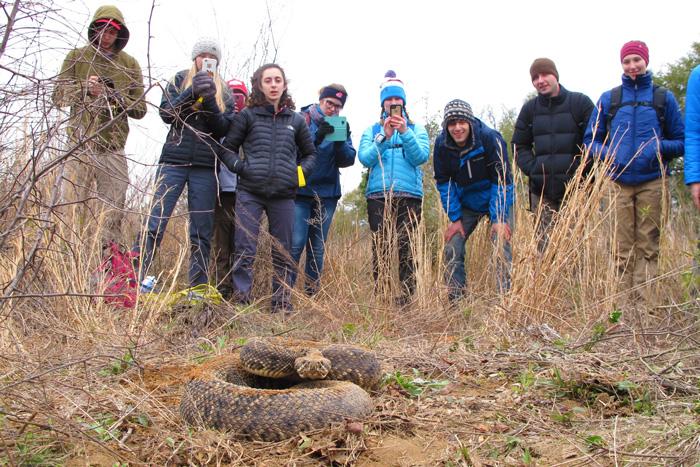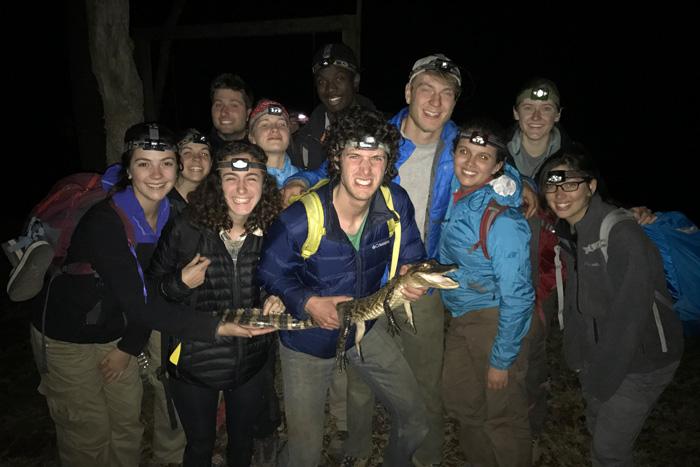Roadkill Is Just the Beginning

"It was the biggest rattlesnake that I've ever seen, without a doubt," Boback says.
Students head to the wilds of Georgia for adventures in field biology
by Tony Moore
Every other spring, Associate Professor of Biology Scott Boback launches a new round of A Natural History of Vertebrates, a class affectionately referred to as the "roadkill class." Boback—who’s known far and wide for breaking ground in how constrictors kill their prey, finding a shocking number of deer (three) in a Burmese python’s digestive tract and growing an awesome beard—sees the course as an exercise in “traditional biology.”
Keep it simple
Boback’s take on traditional biology frames it as a way of acquiring an understanding of the basic biology of animals through a natural history approach, with lots of time spent outside (aka field biology).
“The information that's gained through natural history is foundational to everything else,” he explains, “and yet we continue to go away from basic natural history and observations.” Lamenting the rise of today’s trend of scientists relying more on “very high-octane experimental design-type research,” Boback says he often just likes to keep it simple. “Some of the work that I do in my lab is so basic, and that's why it's so interesting to people,” he says. “It's the question of, like, well how does the snake kill its prey? That's the question that six-year-olds ask all the time.”
Boback’s students, while well-versed in more complicated scientific undertakings, appreciate it as much as he does.
“So much of what you learn on the trip is nothing that can be read in a textbook or taught in a classroom,” says Madison Etchberger ’17 (biology, anthropology). “All of the activities are hands-on, in the field, in all sorts of conditions. Activities from looking for alligators in the pitch black to observing prescribed burns of hundreds of acres. In these activities you’re using conservation field methods that are new and novel to the students, and from there you are allowed, and encouraged, to fail and succeed.”

"It was the biggest rattlesnake that I've ever seen, without a doubt," Boback says.
In the woods and in the classroom
The hands-on activities that made up the bulk of the trip are not only instructive; students see them as about as much fun as you can have while scraping dead animals off the Georgia asphalt in the name of science.
“It's difficult to pick a favorite moment from the trip,” says Micki Williams ’18 (theatre arts, biology). “All these moments were absolutely incredible, unique and memorable. But thinking about the banter and laughs that we had together brings a smile to my face. There is something very different and special about the bond you share with a person when performing taxidermy together in the woods. I feel so fortunate to have bonded with such amazing individuals!”
In the classroom, before the fieldwork begins, Boback covers all the animal bases: from fish to amphibians to mammals to birds. With each animal they study, students learn taxonomies and how to make a formalin-fixed specimen. When they get to mammals, students learn how to skin the mammal, clean it on the inside, stuff it with cotton and then turn it into a museum-quality specimen. For the class’s final project—and here’s where the moniker “roadkill class” really comes into play—students go out and obtain a dead specimen of mammal and a bird and prepare it themselves.
“Nowadays museums rarely perform large-scale collections of specimens as was the tradition when we explored new areas. Instead they are turning more toward molecular biology—now we can take a tissue sample from something and let it go, or we can take a little tiny piece of tissue and archive that, and we can always go back to that," Boback explains. “But there's still value in using actual specimens to learn what that thing is.”

Students stop for a group selfie during a prescribed burn, an event conducted every three or so years by the Georgia Department of Natural Resources and Department of Forestry.
Snakes, pigs and gators
Etchberger is the teaching assistant for the class, and this is the second time she’s been on the Georgia trip.
“Field methods learned on this trip and in the class are really essential to get exposure to as an undergrad, because it provides you with the knowledge to help direct your career path,” she says. “And I think that regardless of my path forward, this course equipped me with the skills to be a quick thinker in unfamiliar situations.”
Those situations included skinning, smoking and eating a feral pig; watching Boback wrestle a huge rattlesnake out of a gopher tortoise burrow (“It was as big around as my leg, I kid you not,” Boback says); trapping and holding a 52-pound alligator snapping turtle in a river; capturing a juvenile alligator; and attending a prescribed burn, in which conservation officers set and maintain controlled fires to help maintain the ecosystem.

With the help of night-vision goggles, students located and caught this juvenile alligator.
For the future
Another aspect of the research trip involved working and talking with members of conservation groups such as the Nature Conservancy, the Georgia Department of Natural Resources and the Georgia Department of Forestry. Boback connects students with them to facilitate conversations about career paths and options, giving students a glimpse of what might lie ahead for them.
“It's experiences like these that are the most thought provoking out of all my time at Dickinson—you think about what the future holds and how much potential we all have to do something that matters with our lives,” says Williams. “The challenges we faced while in Georgia are a great start to getting some practice at working hard, doing something you love and recognizing that not everything goes as planned sometimes—most of the time! And that shouldn't stop you from pushing forward.”
Learn more
Published May 25, 2017